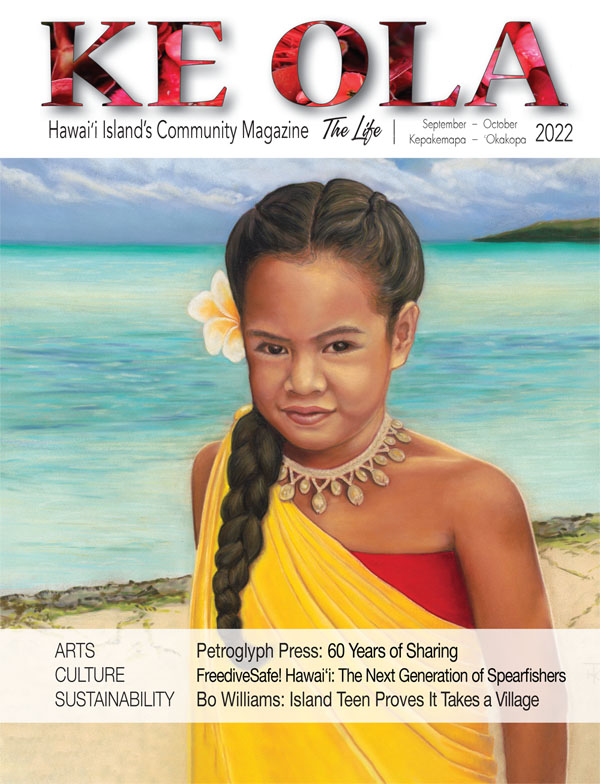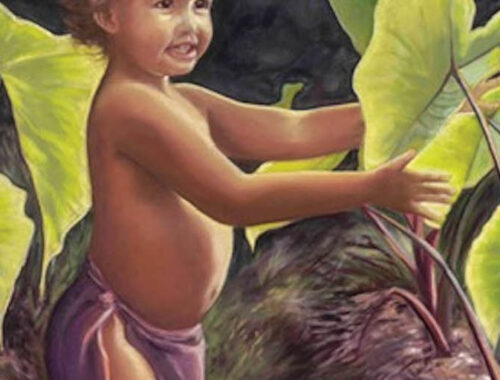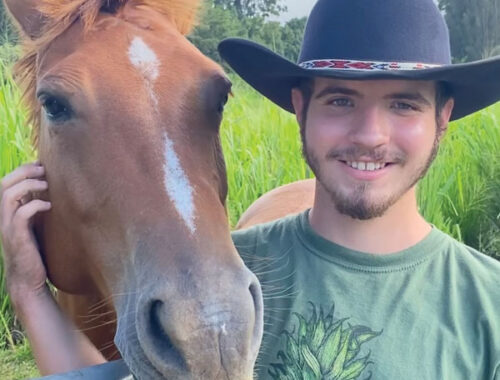
An Album for the Community: Martin Charlot’s Konawaena Mural

By Mālielani Larish
As he approached the entrance to Konawaena High School’s Ellison Onizuka Gym, Martin Charlot gazed up at the mural that wraps around the gym’s façade—a mural painted by his own hands more than 40 years ago. On this weekday afternoon in December 2018, the gym was abuzz with sports activity. From out of the crowded bleachers, a woman strode up to him and introduced herself over the din of squealing sneakers and coach’s whistles. “My entire family flies into Kona, coming back every year to see your mural,” she told him, “because you painted my papa into the mural.”
A wave of gratitude swept over Martin as he steadied himself on his walker. These were truly the perfect words for him to hear, especially since he had arrived at the Keahole Airport just two hours earlier to dedicate the next year and a half to the mural’s complete renovation. Martin had cared enough to form a real relationship with the Konawaena community when he created the mural originally, and now the community represented in those original 38 panels joined together to restore it for future generations.
“A mural is for a community, and you want it to be meaningful for that community,” Martin says, his blue eyes twinkling. That same ethos guided Martin in 1975, when he moved to Kona as a 31-year-old with flowing auburn hair to paint the original mural, which was commissioned by the State Foundation on Culture and the Arts (SFCA). He lived in a teacher’s cottage on the school’s grounds and visited nearby classrooms to make sketches and take photos of the students. Thus, every person in the mural is based on a real person from the Konawaena campus.

With vibrant realism, the mural depicts flora, fauna, and human subjects amidst white sands, azure waters, and multi-hued lava rock. Scenes from Pu‘uhonua o Hōnaunau (Place of Refuge) figure prominently into the mural because Martin was particularly inspired by his visits to this sacred ceremonial site, where fugitives and refugees sought sanctuary in ancient Hawai‘i. He even spent a day with Konawaena students at Hōnaunau, photographing the students bodysurfing and playing in the water, and incorporated these images into the makai (ocean side) of the painting.
At 152’ long and 5’3” high, the mural evokes the same consciousness that animates Hawaiian place chants: the land is dynamically alive and resplendent with mana (power). From the bristle-thighed curlew walking beneath a heiau (Hawaiian temple) to the hawk soaring above an active lava flow, nature’s majesty runs through every panel. The people, such as the Hawaiian warriors who are bursting out of the lava rock, are of the land and engaged with the land in the past, present, and future.
As a young man, when Martin walked over the pahoehoe rocks along the Kona coast, he saw what looked like faces and people emerging from the volcanic tapestry. The mural captures that feeling; not only does every rocky surface convey a sense of active movement, the imagination readily translates different rocks into people and faces. Even the shadows on the white sand seem to glow with vitality. After two years of labor, Martin completed the mural in 1976.
Homecoming

Prior to that afternoon of Martin’s Kona homecoming, he had spent the preceding year and a half coordinating the mural restoration with Shawn Suzuki, who served as Konawaena’s principal at that time. They had already triumphed over several obstacles. First, an unexpected health challenge that came close to claiming Martin’s life had robbed him of his right eye and limited his mobility. Second, the original mural was too degraded by termites and the elements to be touched-up; it needed to be entirely re-created. In fact, the SFCA had called Shawn a decade earlier, requesting that he arrange for the mural’s removal and demolition.
Destroying the mural was out of the question for Shawn, who first learned about the significance of the mural when he started his teaching career at Konawaena in the late 1980s. With the help of a surprise call from a woman who was concerned about the mural’s future, Shawn finally obtained Martin’s contact information and connected with the artist in 2017.
Martin’s gentle voice greeted Shawn over the phone. “Oh my goodness, how wonderful that you called me,” Martin said. “That mural has been on my mind and in my heart for so many years. If you can get that mural down and put a brush in my hand, I will restore it.”
Donations from alumni and the Konawaena Foundation, contributions from local businesses, a GoFundMe page, food sales, and a Zumba marathon raised funds to cover supplies and airfare for the project. Kona coffee grower John Fox made an especially generous donation, bringing the total raised to nearly $60,000.

Martin and his son Kamalu, also a painter, spent over a year repainting the mural. Using photos of each panel, Martin projected them onto the new panels, which are fiberglass-core marine-grade foam sheets guaranteed to outlast wood. Brushstroke by careful brushstroke, Martin spent 10 hours of each weekday carefully re-creating the panels. To commemorate the gym’s namesake, he also added a large portrait of Kona native Ellison Onizuka, who died on the Challenger space shuttle after becoming the first Asian-American in space. Ellison’s astronaut suit looks surprisingly at home in the mural, which already contains flying geometric shapes that symbolize the promise of future innovations.
With the difficult preparations behind him, Martin was able to relax and enjoy the painting process. “I was happy to come back and see the people that had been so nice to me the first time,” he says.
Shawn enjoyed getting to know Martin, who he calls a “state treasure” because of the depth of his knowledge and the enduring connections that he has to Hawai‘i’s past. Martin was graciously hosted by Shawn’s wife’s family, and friends and family flew into Kona to visit him. Students and faculty were fortunate enough to assist with some of the painting, and Governor David Ige even dropped by to lend a hand.
“He had never painted before, but he picked up the brush and did well,” Martin says. “I really enjoyed having him there.”

Island Grown
Martin Charlot’s life story is as rich, varied, and fascinating as the Konawaena mural. His artistic training began under the expert guidance of his art teacher father, Jean Charlot, an internationally acclaimed painter who was a key figure in the Mexican Mural Renaissance. As a little boy, Martin helped grind and mix colors for his dad. When Martin was just five years old, the family left Colorado for O‘ahu for what Jean thought would be a brief stint creating a mural for University of Hawai‘i at Mānoa. Enamored with the islands, and offered a teaching position at the university, Jean and his family decided to stay.

Martin’s roots in the islands run deep. Thanks to his father’s love for Hawaiian culture, he grew up meeting cultural icons like Duke Kahanamoku. He graduated from Saint Louis High School and spent 20 years raising his children, as a farmer and freelance artist in the fertile Waiāhole Valley.
The two years that Martin spent painting the Konawaena mural helped him initiate two new artistic projects. To stay in touch with his four beloved children while he was away, he sent them engaging letters sprinkled with vignettes representing proverbs. Eventually, he collected these proverbs, transformed them into a portrait of a village, and pitched the idea of a proverb mural to his high school buddy Pat Kahler, the CEO of McDonald’s Corporation in Hawai‘i. Pat welcomed the idea, and Martin painted the Hawaiian Folkways proverb mural at the McDonald’s restaurant in Kāne‘ohe in 1985, followed by two more unique murals for the company’s Nimitz and Waikīkī locations. The illustrated proverbs from the Kāne‘ohe mural are published into a keepsake book entitled Local Traffic Only: Proverbs Hawaiian-Style.
Over the years, Martin has also worked as a filmmaker, educator, and childrenʻs book illustrator. Among Martin’s most well-known works is a 200’ long mural depicting pre-contact and modern-day Hawai‘i in Disney’s Aulani Resort lobby, and a mural for the Kahala Theater lobby chronicling movie stars that have made films in the islands. The Smithsonian Institute’s International Gallery exhibited some of Martin’s work as part of a group show called “Revealing Culture” in 2010.
A love for the land is evident in Martin’s artwork, and Martin is particularly proud that the Waiāhole Valley community where he lived from the 1960s to 1990s came together to prevent developers from overtaking the valley. Regarding private land ownership, Martin says “We changed the thinking of the whole country.” Prominent New York newspapers covered the community’s fight, and Barbara Walters even spent a week documenting the grassroots movement to preserve the valley.
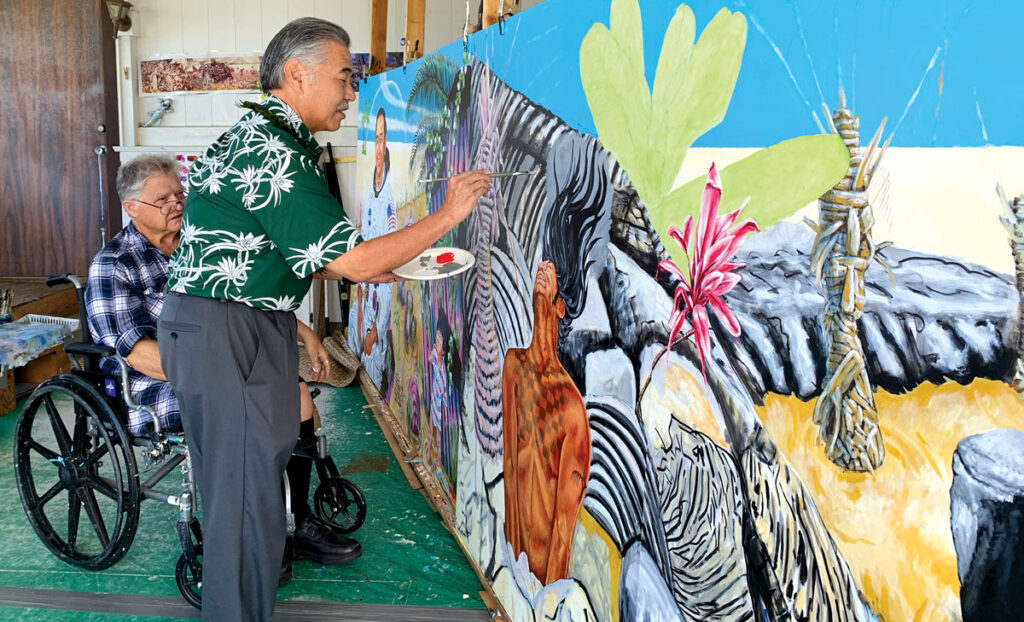
A Community Celebration
On March 6, 2020, which happened to coincide with Martin’s birthday, the community came together to celebrate the mural’s completion.
“It felt very special,” Shawn recalls, to hear many of the attendees point to the mural and say things like “I’m that boy over there,” or, “That is my father bursting from the rock.”
Shawn, who spent 19 years as the Konawaena principal, still speaks in awe when he recalls witnessing the new mural blossom before his eyes. “The patience that he had to get through, it was amazing. It was a once-in-a-lifetime experience, for sure.” ❖
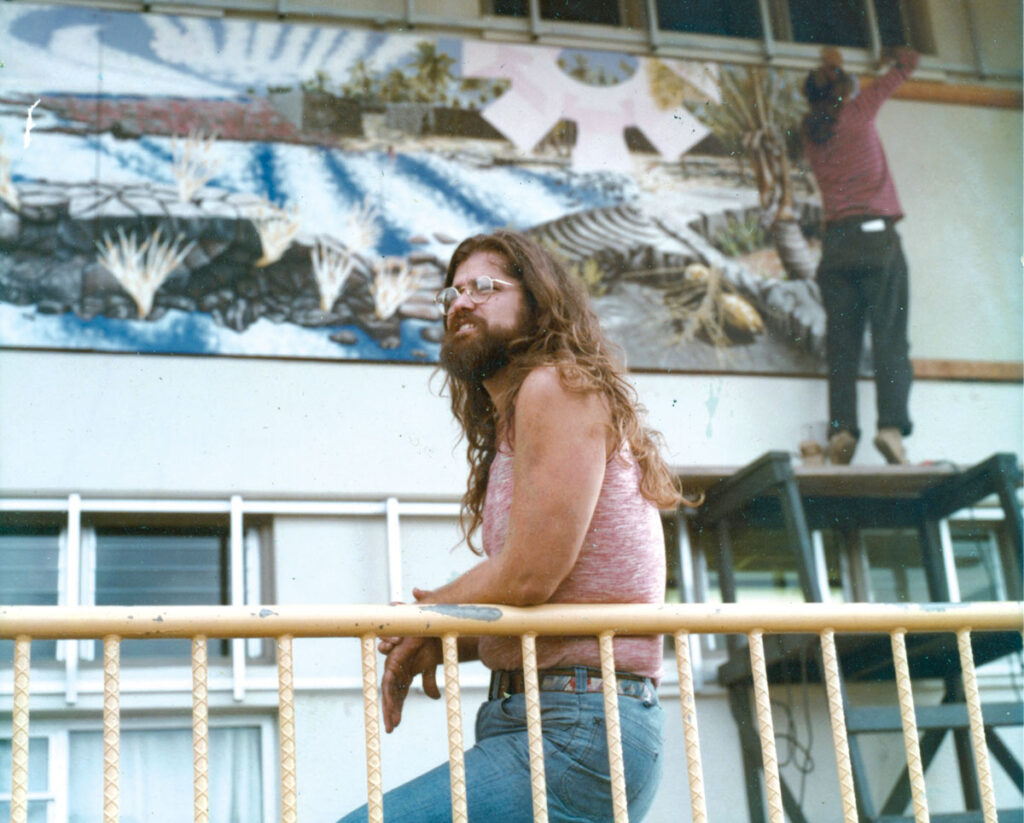
All photos courtesy of Martin Charlot
